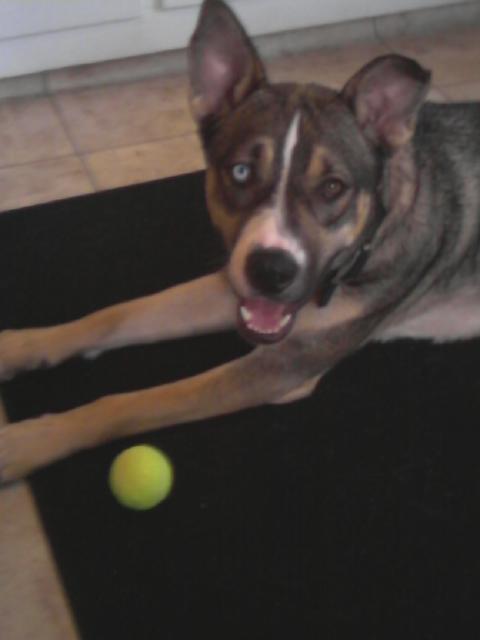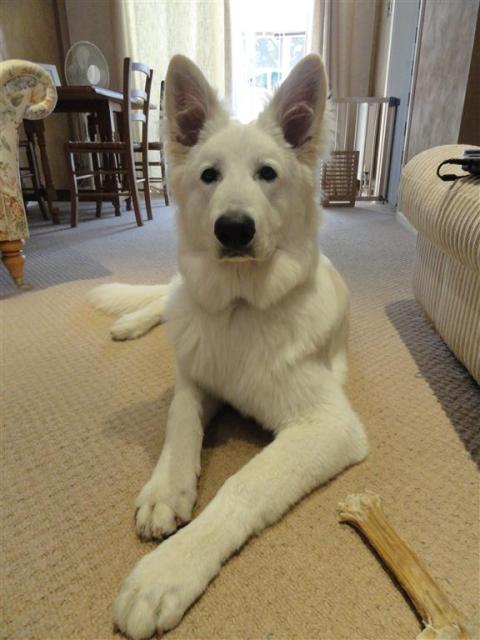QuestionHI CATHY,
WE HAVE 2 MALE LABS.SONNY IS ABOUT 20 MONTHS OLD.JARRETT IS 8 YEARS OLD. BOTH INDOOR PETS..BOTH EQUALLY SPOILED ROTTEN.ABOUT 3 MONTHS AGO THEY GOT INTO A MAJOR FIGHT.I HAVE NO CLUE AS TO WHAT SET THEM OFF. I WAS HOME ALONE AND I COULD NOT FOR THE LIFE OF ME GET THEM SEPERATED.I THOUGHT FOR SURE SONNY WAS KILLING JARRETT.AFTER FOR WHAT SEEMED LIKE A LIFETIME, I SOMEHOW GOT AHOLD OF JARRETT AND WAS ABLE TO GET HIM OUTSIDE.YOU SHOULD HAVE SEEN THE HOUSE.HAIR,SPIT,BLOOD AND THE FURNITURE WAS TIPPED OVER. I LOOKED SONNY OVER FOR WOUNDS, HE HAD NONE.I WENT OUTSIDE AND LOOKED JARRETT OVER.HE HAD 2 MAJOR WOUNDS ON HIS SHOULDER AND MULTIPLE BITE MARKS ON HIS NECK.I TOOK HIM TO OUR VET AND HE ENDED UP NEEDING SURGERY.HE ALSO WAS CASTRATED.SONNY WAS CASTRATED A FEW DAYS LATER.AFTER ABOUT A WEEK AFTER THE FIGHT WE HAD THEM BOTH BACK IN THE HOUSE BUT SEPERATED.WE PUT UP A BABY GATE ACROSS HALF OF THE HOUSE AND KEPT JARRETT ON ONE END OF THE HOUSE AND SONNY ON THE OTHER END.ROTATING THROUGHOUT THE DAY.AT NIGHT TIME, MY HUSBAND IN ONE BEDROOM WITH SONNY ME IN THE OTHER ROOM WITH JARRETT WITH GATES ACROSS THE DOORS.IF THEY EVEN GOT A GLIMPSE OF EACH OTHER THEY WOULD GROWL.AFTER ABOUT 6 WEEKS OF LIVING LIKE THIS, THEY SLOWLY WE THOUGHT WERE KINDA GETTING ALONG.TAILS STARTED WAGGING MORE THEN THE GROWLING..BUT, ONE SATURDAY MORNING I WAS ON ONE END OF THE LIVINGROOM WITH JARRETT BY MY SIDE, MY HUSBAND ON THE OTHER END OF THE ROOM WITH SONNY BY HIS SIDE WHEN HELL BROKE LOOSE AND THEY WENT AT IT JUST LIKE THAT..THIS TIME, SENDING MY HUSBAND TO THE ER..BIG BITE ON HIS ARM BUT HE IS O.K....HE THAT DAY AND UP TO TODAY EVEN, HE IS ALL SET ON HAVING JARRETT PUT DOWN OR GIVEN AWAY TO A GOOD HOME...
WELL, I HAVE PERSUADED HIM TO LET ME KEEP JARRETT BUT WE HAVE TO KEEP HIM OUTSIDE IN OUR PEN..JARRETT HAS ALWAYS BEEN A INSIDE/OUTSIDE DOG BUT MAINLY INSIDE..I GET HIM OUT OF THE PEN THROUGHOUT THE DAY AND HE GETS TO PLAY IN HIS DOGGIE POOL ON HOT DAYS..BUT, IT BREAKS MY HEART THAT HE IS OUTSIDE...WE ARE SCARED TO DEATH TO EVEN THINK ABOUT TRYING TO LET THEM OUT IN THE YARD AT THE SAME TIME AS NIETHER OF US WANT TO WITNESS ANOTHER FIGHT..WE HAVE TRIED A AIRHORN BUT DOES NOT PHASE THEM..WE HAVE NOT TRIED THE SPRAYING WATER WITH A HOSE AS THEY ARE INSIDE..WE CANNOT AFFORD A PROFESSIONAL AT THIS TIME BECAUSE WE JUST HAD TO GIVE THE VET $850.00 FOR A EMERGENCY SURGERY ON SONNY DUE TO THE FACT THAT HE HAD A BAD HABIT OF SWALLOWING ROCKS AND HAD TO HAVE THEM (10) REMOVED..BUT THAT IS A DIFFERENT STORY RIGHT NOW..WE HAVE THAT UNDER CONTROL BY GETTING ALL ROCKS OUT OF THE YARD..WHAT OUR PLAN IS, WE HAVE BEEN THINKING ABOUT GETTING SHOCK COLLARS FOR EACH OF THEM..WHAT WE NEED TO KNOW IS, DO YOU THINK IT WOULD WORK?? OR IS IT POSSIBLE THAT THEY WOULD JUST CONTINUE TO GO AT IT???????
PLEASE HELP AS I DONOT HAVE THE HEART TO HAVE TO GIVE EITHER DOG AWAY...
THANK YOU..
THERESA
AnswerHi Theresa,
Before I forget, when you have dogs like this with a tendancy to fight -- I always recommend having large bowls of water sitting around. If you dump water on the dogs while fighting, it usually breaks them up enough to safely get them apart.
I do not recommend shock collars at all, especially in this situation. I have seen them have a reverse affect and cause even more aggression. The collar scares the dog and they go into an even worse frenzy.
I really don't believe in keeping dogs outside, and it wouldn't be fair to Jarret to be outside, especially since he knows how good it is to be inside.
You do have a serious problem and it seems like have done everything right as far as trying to work with them. You had them both neutered, you separated them and took it slow putting them back together again.
Here are some tips re dealing with aggression between the two dogs.
Dog Tip: Aggression Between Dogs in the Same Household
The following article contains notes from Larry Lachman's book, Dogs on the Couch:
When it comes to fighting between dogs in the same household, there are four common characteristics:
* Dogs are of the same sex.
* Dogs fight only in the owner's presence.
* Dogs are adult dogs, four years or older.
* Fights involve a struggle for which one will be the dominant dog in the family pack. And in these cases, the owners frequently choose to wrong dog as the dominant dog and begin treating him as such. Or the owners attempt to treat the dogs equally and democratically.
Lachman's advice for reducing aggression between dogs in the same household:
* Grant privileges to the dominant dog. Greet, feed, pet, walk outside with dominant dog first.
* Be consistent in all roles. Maintain a clear-cut hierarchy and help the dogs feel secure in their position in the family pack.
* Discipline the less-dominant dog for horning in on the dominant dog using SSR, Lachman's approach to changing a dog's behavior. SSR stands for Startle (wait 5 minutes), Redirect and then Reward. Lachman recommends using a relatively quiet method of startling the dog, such as firmly stating "OFF!", which you can combine with a loud clap or another unpleasant, interruptive noise. If that doesn't work, he suggests a spritz of water at the dog using a spray bottle, although some trainers do not advise the spray bottle approach. Next, wait 5 minutes, then redirect the dog's attention to you. Reward the dog for redirecting his attention to you.
* Only give dogs attention when they are together. Give attention to dominant dog first.
* Do daily reconditioning exercises: one family member with one dog on one side of yard on leash (and anti-pull device if needed), and the other dog with another family member on the opposite side of the yard. Each dog does 10 sits, 10 downs and a 5-minute stay. Use positive reinforcement.
* Bring dogs closer during the sessions until after 2 to 4 weeks (still on leash) they are side by side doing their downs, sits. Any growling, lunging, aggressive squaring off or breaking stays results in a SRR reprimand.
* After success with this, add a 15-minute cooling down session following the yard exercises. Do this inside the home on the couch, with one person holding one dog at each end of the couch. Gradually bring them closer until (still on leash) they are working through their commands side by side without any provocation.
* At 6 to 8 weeks, do yard and in-home exercises off leash. Remain armed with startle devices.
* Add daily 15 to 30 minute heeling walk, with dominant dog 6 to 10 feet ahead. Discipline submissive dog if he tries to pull ahead -- cut him off, circle around and end up in sit-stay.
* Rub a towel or old shirt on dominant dog to get his scent on it, then put it where submissive dog sleeps and eats. Do the same with the other dog. This helps establish a positive association for each dog with the other dog's scent.
* Separate the dogs when you leave home. When you can't give both dogs attention, neither gets any.
* Have dogs sleep with human pack leaders each night. Dominant dog goes into room first, on leash, then tethered or crated by side of the bed (never tether a dog and leave it alone). Then do same with other dog.
* In the morning, lead the dominant dog out first.
* Separate eating areas.
* Avoid greeting, playing or petting the dogs for any length of time in tight spaces such as hallways, car entrances. These are likely hot spots where dogs begin fighting.
* If any fights break out, yell "OFF!" and blast with water or airhorn or ultrasonic device. If the dogs fail to respond, grab the more aggressive dogUs rear legs or tail and lift up, suspending the dog and removing his center of gravity while rapidly moving back. Do not reach for the head area or grab collars: youUll more than likely get bitten.
* Never have either dog on the same physical plane or level as you. That will reduce your dominant position in the pack. The dogs will respect you less and will ignore you if you command them to stop provoking each other or to stop fighting.
* Never respond to either dog's demand for attention. This is also a subtle way to reduce your authority position, thereby dangerously raising the dog's perception that his position is one of greater authority.
Temporary medication may also be required to take the edge off and give the behavior therapy time to kick in. There seems to be more success if both dogs are giving the medication. Choices include Elavil (amitriptyline) and BuSpar. However, medication alone will not work. A comprehensive behavior therapy intervention, including reconditioning, non-force obedience and human family therapy intervention -- changing the owner's mindset and behaviors -- is also needed to bring about a permanent cure. Three out of five cases treated with the methods described above work out. It will take 8 to 12 weeks of consistently implementing the program to achieve lasting results.
As with human sibling rivalry, owners must modify and change their own behaviors toward the fighting dogs. Punishment typically only serves to bring out aggression and creates new problems. Lachman recommends the use of behavior modification in combination with family systems therapy. This kind of therapy involves establishing healthy boundaries between members of the family, including the dogs, and maintaining a clear hierarchy, while at the same time fostering a sense of loyalty and belonging.
Let me know how things go for you.
Cathy

 Designating bathroom area
Question
backyard
I have 2 medium mutts that are both b
Designating bathroom area
Question
backyard
I have 2 medium mutts that are both b
 Dog tackling
Question
My dog
I would like to know a technique or a t
Dog tackling
Question
My dog
I would like to know a technique or a t
 Barking at strangers
Question
Kupe
We have a 7 month old (not neutered) male
Barking at strangers
Question
Kupe
We have a 7 month old (not neutered) male
 My dog just cant seem to get the hang of peeing or pooping outside.
Question
This is Trevor
Im a twin and I am a boy. My si
My dog just cant seem to get the hang of peeing or pooping outside.
Question
This is Trevor
Im a twin and I am a boy. My si
 Shih tzu toilet training
Question
Shih Tzu Chihuahua
We have a Shihtzu/Chihuahua
Shih tzu toilet training
Question
Shih Tzu Chihuahua
We have a Shihtzu/Chihuahua